Looming Lake Mead disaster: How Colorado River cities are preparing for shortages
LAS VEGAS – The grass beneath the palm trees at the Foothills has no function other than to look lush and inviting for people driving up to the gated community’s entrance.
The homeowners’ association there, like many that govern such developments dating to the 1980s and 1990s, was still sprinkling Colorado River water on about 50,000 square feet of turf this year. It takes an estimated 73 gallons a year to water every square foot, according to the local water authority. If poured on all at once, it could bury the grass under a 10-foot pool.
But soon, in a show of respect for the dwindling river, that watering will end.

“Nobody comes out here to kick a soccer ball. The HOA isn’t holding community events here,” said Bronson Mack, spokesman for the Southern Nevada Water Authority. “This needs to go.”
Cities alone cannot overcome the deepening water shortage that a warming climate and overuse have wrought on the Southwest, not when most of the water is used on farms. Even cutting off all of the cities that rely on that source would not reverse the disastrous trajectory the region’s reservoirs have been on for years, a fact repeated by multiple officials at an annual Las Vegas conference of the Colorado River Water Users Association this month.
But those same officials from across the watershed also insist the crisis requires sacrifices from “every state, every sector,” which puts pressure on urban water providers to adapt rapidly.

Long a regional leader in safeguarding its scant water supplies, the Las Vegas area is kicking its mandatory conservation efforts into overdrive as the Colorado River’s decline sends the entire Southwest into crisis mode. In the last year, the Water Authority and the Nevada Legislature have worked in tandem to ratchet up the water restrictions, banning new golf courses that draw river water from its storage pool nearby in Lake Mead, and limiting the size of new residential pools.
Perhaps the most consequential step is a new state law mandating the removal of “nonfunctional turf,” like that at the Foothills, by 2027.
The cost won’t fall solely on the property owners. As it has done in yanking out half of the Las Vegas Valley’s grass over 20 years, saving 11 billion gallons a year, the Southern Nevada Water Authority will pay the Foothills for its trouble. The incentive may go away before the mandate goes into effect, but for now it is $3 a square foot on a property owner’s first 10,000 square feet, and $1.50 after that.
Cities take steps to conserve, secure supplies as Lake Mead crisis looms
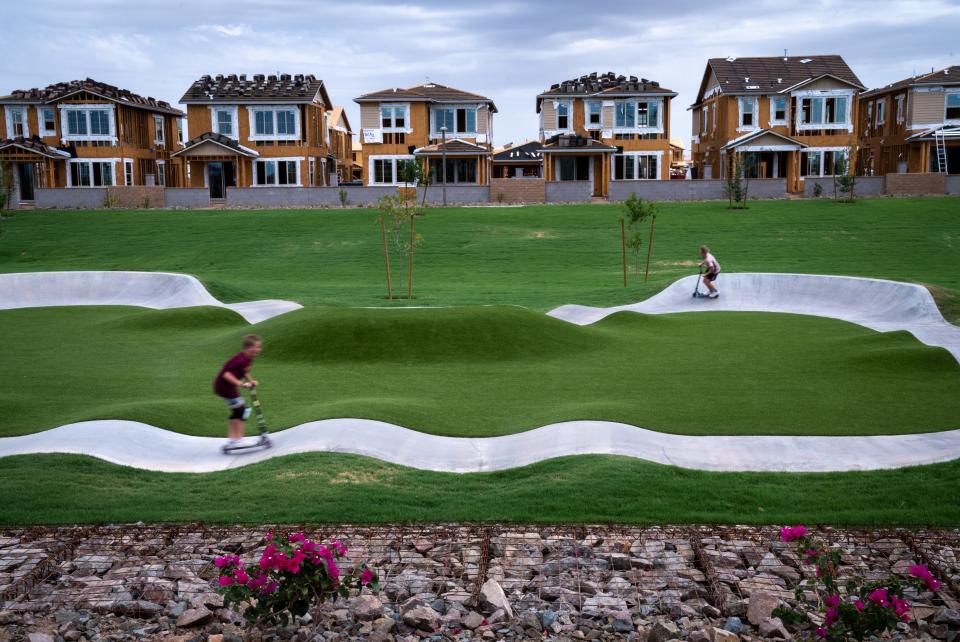
The major cities relying on the Colorado River’s largely depleted reservoirs have all embarked on climate adaptations they hope will help them maintain economic and population growth. In Las Vegas, it’s a combination of aggressive water restrictions, a massive return of treated wastewater back into Lake Mead and a $1.3 billion-dollar tap and pump station to reach deeper into the reservoir.
In Phoenix, it’s a new $295 million pipeline to ensure some 400,000 people who rely on the Colorado River can connect to other sources. Denver this year gained state support in joining the effort to pay residents to remove turf. Salt Lake City, where residents fear they’ll lose their namesake water body, cut back by 15% during this year’s irrigation season. Los Angeles is developing a $3.4 billion water-recycling plant with help from Arizona and Nevada.
Lake Mead has declined through two decades of a warming and drying climate and continued overuse, leaving it just over a quarter full. Lakes Mead and Powell together held several years of the river’s flow 22 years ago, but now contain about one year’s worth of what the river has delivered on average in this century. The result is a supply crisis that led Congress to allocate $4 billion for drought management this year. Much of that money will upgrade farm irrigation systems for efficiency, and some will reward farmers for not growing crops on some fields for the next few years.
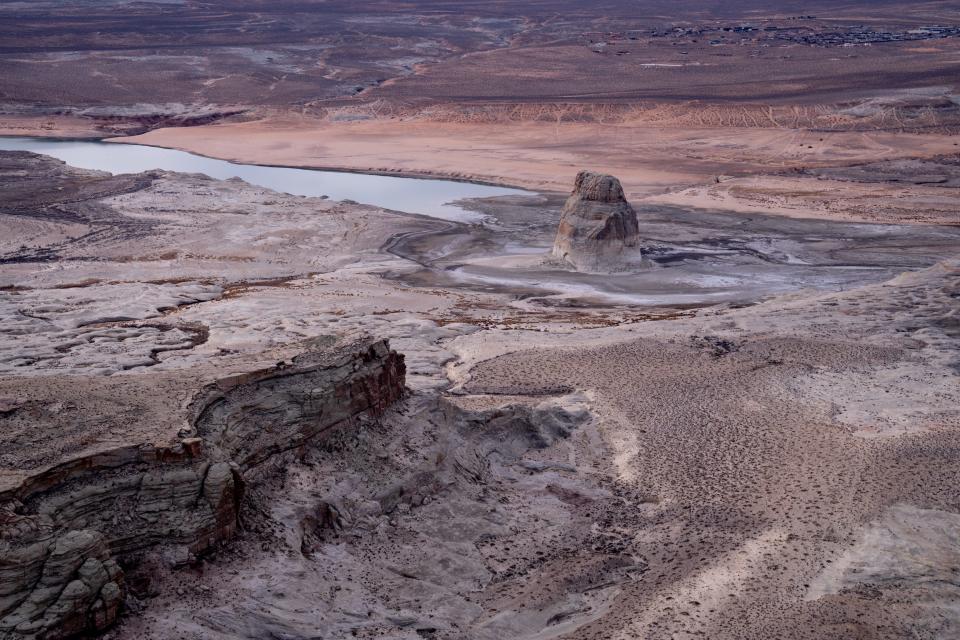
That money is nowhere near enough, Southern Nevada Water Authority General Manager John Entsminger told colleagues at the river users’ conference. Florida alone collects more support and insurance after a single hurricane, he said. The Colorado River needs “massive federal investment.”
“We need to really start thinking of this as a national emergency.”
“It makes me really sad that things are this bad,” water policy expert Kathryn Sorensen told The Arizona Republic, part of the USA TODAY Network. At different times she previously led the water utilities for both Phoenix and Mesa, and she now directs research at Arizona State University’s Kyl Center for Water Policy.
That sadness doesn’t translate into fear for urban Arizona’s immediate future. Arizona’s farms will suffer with reductions of flow past Hoover Dam, but the Phoenix and Tucson areas are well equipped to weather years more of drought.
In Tucson, that’s because the city relies on wells for its drinking water, and has used its share of the Colorado River to replenish its groundwater. In metro Phoenix, it’s a combination of vast stores of groundwater and a major supply from the Salt and Verde rivers.
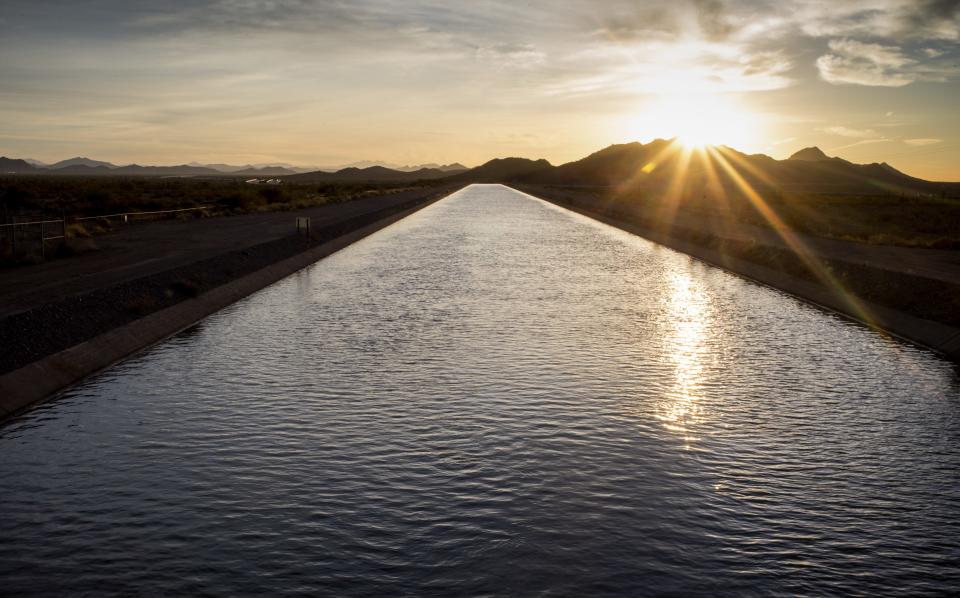
Cities in Maricopa County currently rely on the Colorado River to varying degrees. Phoenix takes about a third of its tap water from the river, and gets most of the rest from the Salt and Verde rivers, according to data compiled by the Kyl Center. Scottsdale gets more than two-thirds of its drinking water from the Colorado River. The part of Anthem that’s east of Interstate 17 gets all of its tap water from the river.
The river’s decline already has forced the CAP to cut deliveries to the Phoenix and Tucson areas, and in 2023 the reduction will rise to more than a third of the water the canal once carried. But most of that pain has fallen on farmers. The minimal reduction to municipal supplies largely involves water that was being pumped across the desert and sunk in the ground for future use.
There's ample water in the Colorado River, but conservation is important
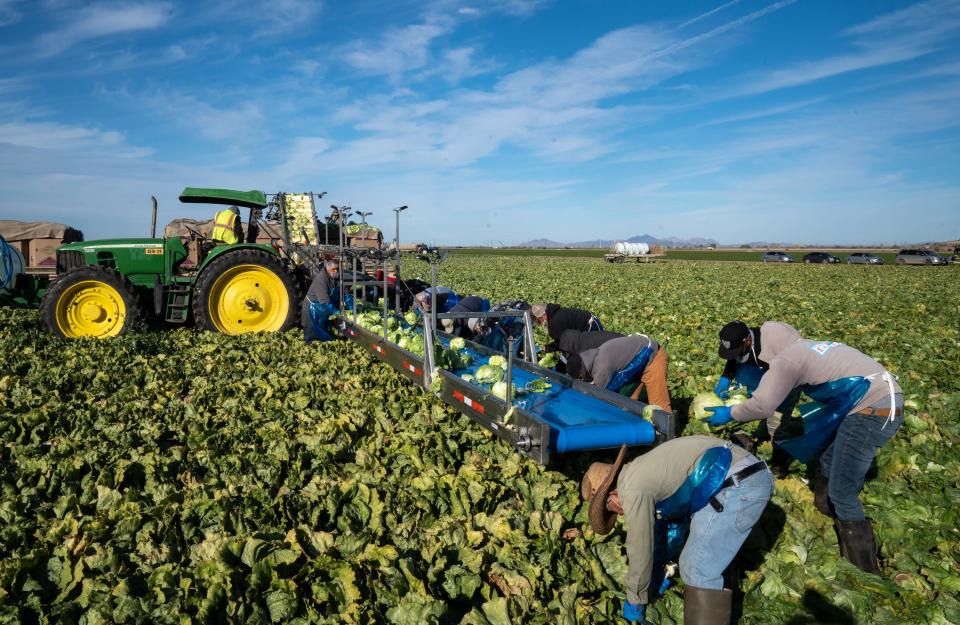
The cities can weather more reductions, Sorensen said. If CAP were to lose its entire supply, Phoenix would still have enough groundwater and Salt-Verde water for decades, though it would begin to draw down its aquifers.
Arizona’s state water chief agreed that there is a vast supply that cities could tap for decades. As long as water flows through the CAP canal — even at increasingly curtailed rates — Arizona’s cities will be able to supply indoor water to residents, Department of Water Resources Director Tom Buschatzke said.

“Supplies are robust enough that I don’t think anyone needs to worry about their indoor water use being curtailed,” he said.
That confidence may not apply across the board if the river stops flowing out of Lake Mead and the CAP is entirely cut off. Even then, though, most cities — and certainly Phoenix — could supply sufficient tap water for the foreseeable future.
Nonetheless, Buschatzke said, the cities and their residents must reduce their outdoor water consumption to persuade farmers and the farm irrigation districts who control most Colorado River water to do the same.
Farms use roughly 80% of the river’s water, and the big agricultural districts in Yuma and Southern California have among the oldest and most secure legal rights to the water. Before the Arizona Water Banking Authority allows cities to tap the water it has stored underground, Buschatzke said, it should insist that cities either impose urban landscape watering restrictions or offer rebates to residents who remove grass. Either option would move Arizona cities closer to the Las Vegas model.
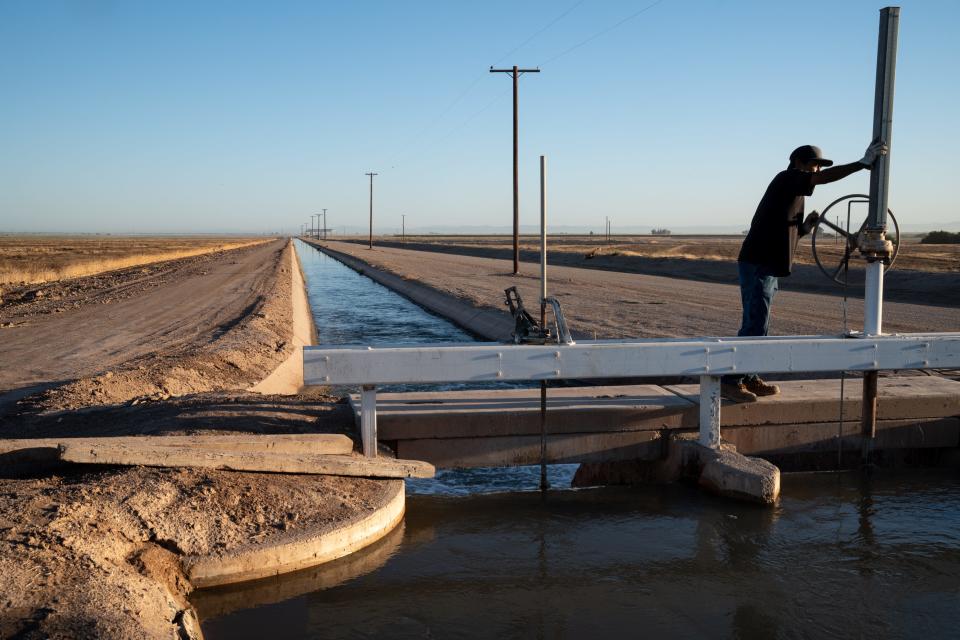
The big water savings must come from farms, Buschatzke acknowledged. But unless Arizona cities change the “optics” by ramping up conservation, farmers are likely to fight until the river dries up.
“The ultimate nightmare outcome is no water in the CAP canal,” he said. “That’s the risk.”
The U.S. Bureau of Reclamation this month collected suggestions about dam-management ideas in the face of a deepening emergency. CAP joined the Southern Nevada Water Authority and the Metropolitan Water District of Los Angeles in a letter asking the agency to ensure that cities continue to get some water from Lake Mead regardless of where how their rights stack up against farms. They've collectively spent hundreds of millions of dollars to keep water in the reservoir over the last 20 years, they said, and they need continued access to it.
"The preferred alternative needs to assure that operations of the reservoirs provide sufficient water to meet public health, safety and welfare needs," they said.
Some fast-growing suburbs hold less-resilient supplies. In the past, housing developers could pump groundwater and then pay into the Central Arizona Groundwater Replenishment District with a goal of finding water to replace it. But with the biggest source of replenishment water — the Colorado River — now in shortage, there are fewer options to prove the availability of a secure, 100-year supply legally required for new housing tracts.
It’s one reason a state water finance board signed on to consider buying water from a more plentiful but much costlier source: the Pacific Ocean. A proposed ocean desalination plant would pipe water from Mexico’s Sea of Cortez to resupply central Arizona. The plan pitched in December by an Israeli company would send the pipeline through Buckeye, one of the suburbs in need of a source for thousands of envisioned homes.
There’s enough water for existing homes, Sorensen said, though a worsening shortage on the river could force some communities to bargain with their neighbors to get it. It might require changes in laws or contracts, but she expects communities to partner when they have no other option.
“The cities are going to move water around,” she said. “They are going to dig deep on conservation.”
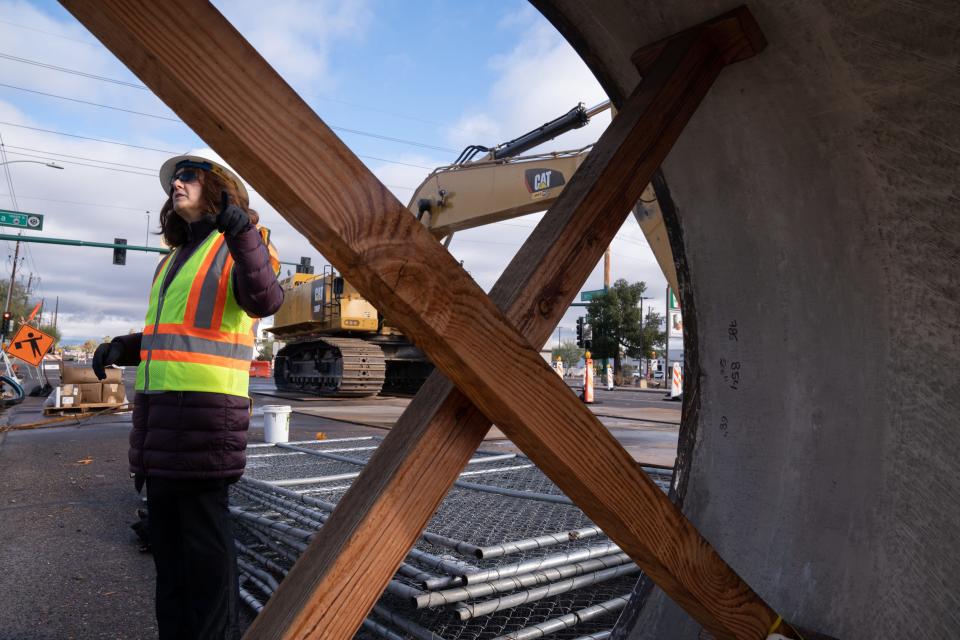
But moving water is only as easy and cheap as cities' delivery systems make it. That is, it’s expensive and takes years of planning.
Sorensen knows this firsthand. When she led the Phoenix water department, she advocated and got approval for a major new pipeline connecting Colorado River-dependent residents in north Phoenix to the Salt-Verde supply as a backup. That pipeline will begin delivering up to 75 million gallons a day for some 400,000 residents later this winter.
Phoenix started work on the 66-inch pipe in 2018, when Lake Mead’s decline had pushed the state into planning for drought contingencies. The city budgeted $295 million for it, and it has added $2.37 to the average city customer’s monthly bill. It runs 9 miles from a water treatment plant south of Piestewa Peak to a link with another big pipe near 32nd Street and Bell Road. The last truck-length section of it sat in a closed traffic lane on Shea Boulevard this month, and water quality tests will follow its installation.
Sorensen said that other cities may need to build pipelines to enable adequate flow from neighboring systems.
In the meantime, she expects Arizonans will continue using less even without new restrictions. Voluntary conservation and desert-adapted landscaping have allowed some cities to grow without increasing consumption. Over the CAP’s three-county service area, the population has grown 45% in two decades while increasing water consumption by only 15%, according to the Kyl Center data.
In Phoenix, where 80% of homes in 1970 were estimated to have lush lawns with more than 60% grass, now less than 15% do.
“It’s great that Vegas is going after turf,” Sorensen said, “but we’ve been going after it for decades.”
In Las Vegas, a war on turf succeeds
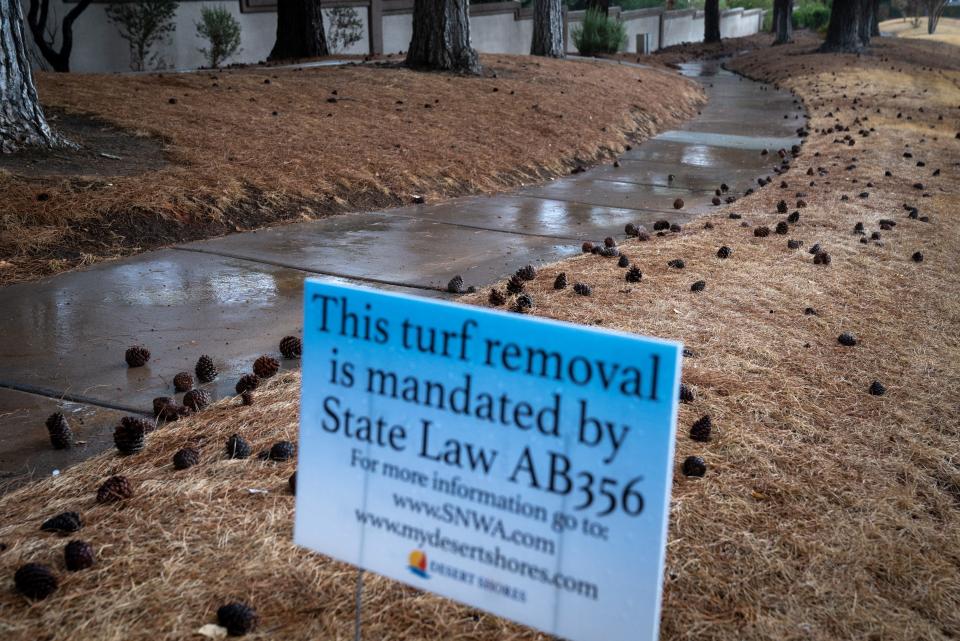
The war on grass is simply more intense in Las Vegas, and understandably so. The city and surrounding Clark County take about 90% of their water from the river at Lake Mead. There is no backup.
The Southern Nevada Water Authority has put golf courses on a water budget of 6.3 acre-feet per irrigated acre. An acre-foot, the federal government’s preferred water measuring unit, is about 326,000 gallons, and can supply about three households for a year.
Next year, the courses will have to cut back to 4 acre-feet. It means removing grass from nonessential areas around clubhouses and parking lots.
“It’s enough to keep it green, but it does force golf course managers to make decisions on what they’ll keep green,” Mack said.
So far the valley’s courses have removed 900 acres of grass, he said, equaling nine professional courses.

The Las Vegas area still has roughly 3,900 acres of nonfunctional turf around businesses, apartment complexes and HOAs, all of which must be removed within five years. Another 1,000 acres grow in the lawns in front of single-family homes. That turf’s removal is not mandated by law, but Mack said his agency would continue to offer dollar incentives to nix it.
The result is that Las Vegas actually uses less water now than it did before the drought, even after adding hundreds of thousands of residents.
At Sun City Anthem, a suburban Las Vegas housing and recreational community for 13,000 people aged 55 and older, facilities and landscape manager Larry Fossan supervised this fall while workers dumped 710 tons of rock on a hillside yard that had been grass a few weeks earlier. This 53,000 square feet of grass, outside a community and recreation center, was deemed nonfunctional. The law required its removal before 2027.
The conversion to a rocky slope with flowering plants and trees would take the yearly water demand per square foot down from 73 gallons to 19, he said. More than the water savings, though, he looked forward to saving an estimated 14% on maintenance and yard labor that had run into the hundreds of thousands of dollars. Simply eliminating hedges that needed trimming around the parking lot will save $32,000 a year, he said.
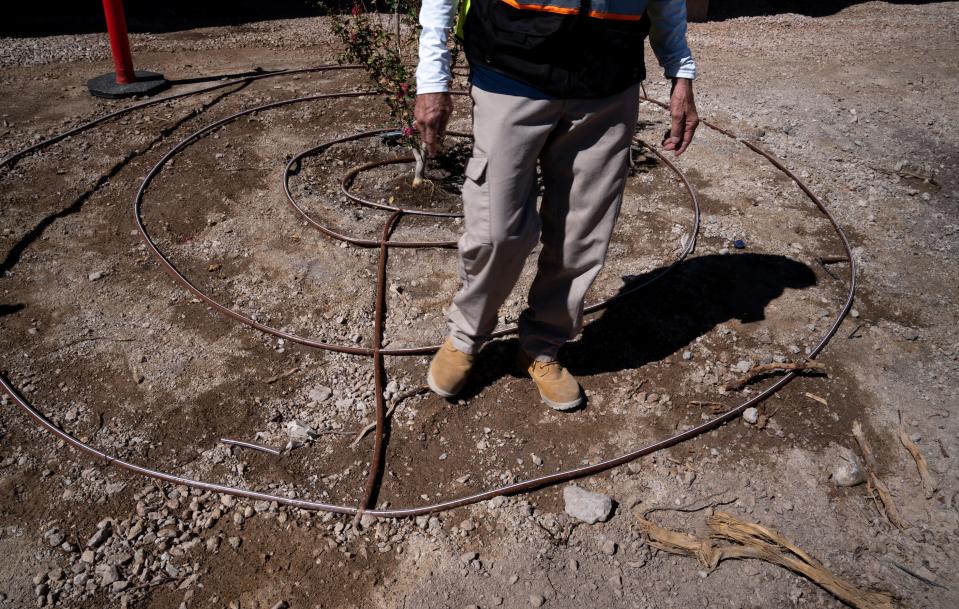
The community is learning new ways to keep up inviting but more sustainable appearances. It requires experimentation, Fossan said, including with rings of irrigation line that now spiral out from the existing trees that were formerly watered along with the grass. Over time the workers will cut off the spirals closest to the tree, forcing the roots to stretch outward.
“We’re training our trees to go look for water,” he said.
Such conversions are not cheap, especially at this scale. The work cost $429,000, and the water authority’s rebates covered $137,000, according to Fossan. Over time, he expects, it will pay for itself.
In Utah, a water pipeline plan waits
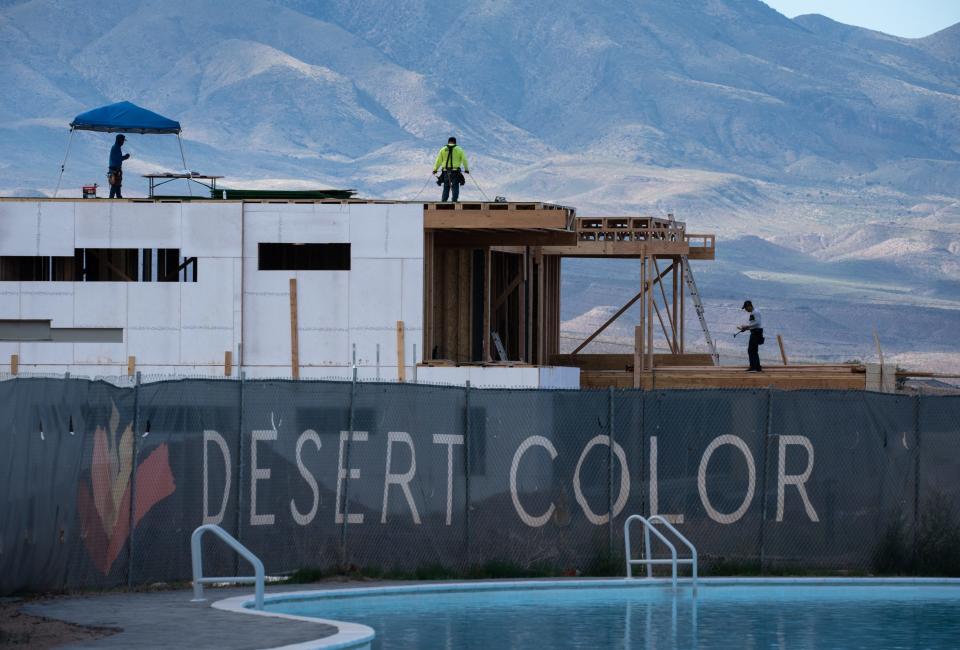
In St. George, Utah, a two-hour drive north across the Mojave Desert, developers in the West’s fastest-growing town are looking to start out using little water so they won’t have to pare back later. The city and surrounding Washington County have roughly doubled to nearly 200,000 people in the last 20 years, with St. George accounting for half of that population. All of it is happening in a water-limited stretch of the Colorado River Basin, the Virgin River watershed.
To handle the growth, local water managers years ago proposed a pipeline from Lake Powell, the Colorado River’s second-largest reservoir behind Mead. Utah would have been within its rights to use more Colorado River water under the 100-year-old compact splitting the water among states. But as the crisis has deepened, it’s unclear how reliable new projects could be if they take water that’s accounted for elsewhere.
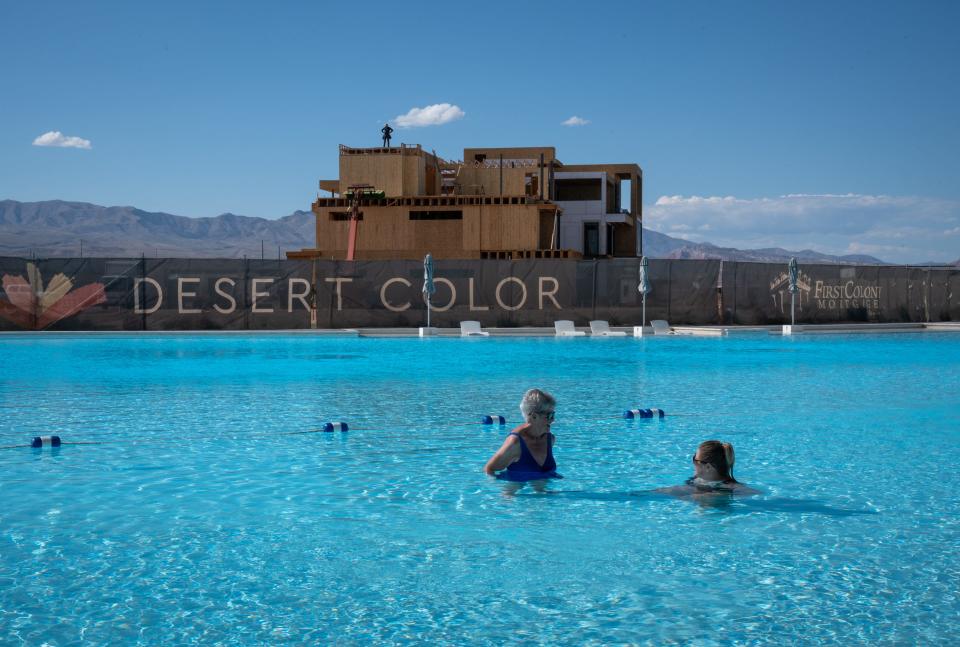
For that reason, Washington County Water Conservancy District General Manager Zach Renstrom said, the area is focused on water conservation and reuse projects.
A new development to the city’s south is a prime example, he said. Desert Color is clustering homes around grassy play areas instead of laying out individual lawns front and back. The developer wanted a large recreational pond at its center, but agreed to fill it with brackish groundwater that’s unfit for household or farm consumption. It’s reusing water for irrigation, an early step in what Renstrom hopes will become a $600 million countywide recycling program.
“It’s effective and it’s functional,” Renstrom said, a model for future development.
Desert Color marketing manager Ryan Coates took Republic journalists on a tour of the growing development, where about 650 of an eventual 11,000 homes have gone up. The neighborhood is largely xeriscaped, with some strips of shared grass between rows of homes. Each home has two meters, one for culinary and one for irrigation water. There is no golf course, though there’s access to courses nearby.

The result, Coates said, is a development that will use 40% less than others in Washington County. It’s an example of what the area has learned from Las Vegas, he said.
“Southern Utah is definitely getting there," Coates said.
St. George still wants its Lake Powell Pipeline, Renstrom said. “With all the numbers of people trying to come there, we have to do something” to add supplies, he said. But that will have to wait until the states finish a renegotiation of shortage-sharing guidelines that are set to expire by 2026.
Utah gets a bad rap among Colorado River users because it continues to seek a new pipeline from a source that has no more to give, Entsminger said. In reality, he said, all states are doing effectively the same thing, just by welcoming new residents. Las Vegas continues to approve building permits, he noted.
“The cities are growing," Entsminger said.
Returning treated water reduces footprint
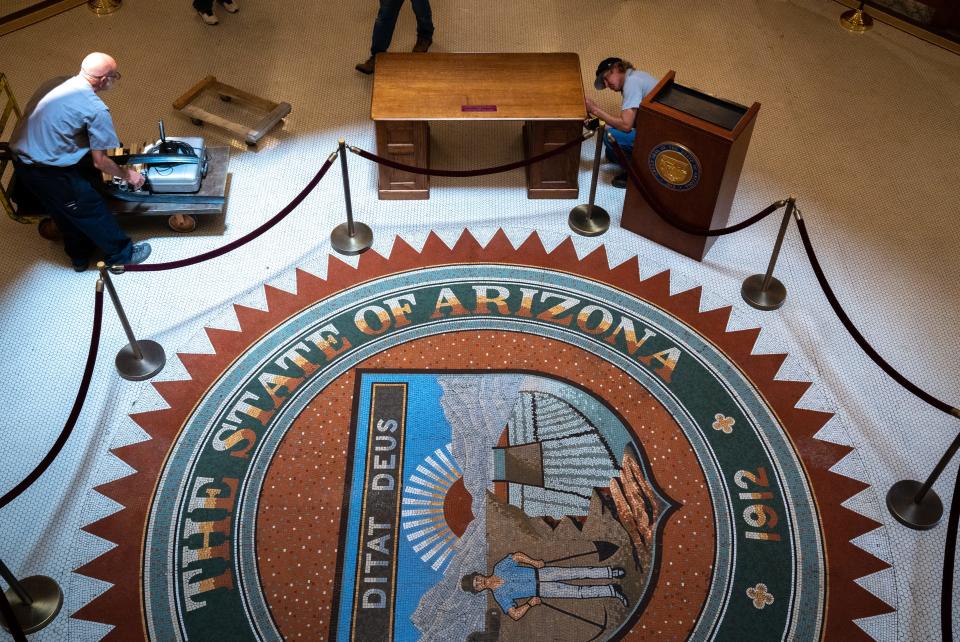
That’s a big problem for some. John Weisheit, a river runner and environmentalist, moved from Phoenix to Moab, Utah, decades ago to escape growth and enjoy the river. Since then, he said, he’s learned that “you can’t run away from the problem.” Water shortages are affecting Utahns and may take a big human toll when there’s too little to support the millions more expected to move into the region, he said. He specifically criticized continuing development in Las Vegas, where there’s no alternative to pumping river water.
“I see social disruption” in the future, he said.
Public officials and water experts generally say the Southwest can’t stop people from moving where they want, but market forces someday could. As Central Arizona Project General Manager Ted Cooke put it, people may make different choices about where to move as the region’s water becomes scarcer and more expensive. Sorensen, the ASU water researcher, said cities should zone their developments with water conservation in mind, emphasizing denser housing with fewer individual lawns.
Entsminger advised urban water providers to seek a “negative footprint” in water consumption, using less even as they grow.
Las Vegas has achieved that, in part by spending nearly $300 million on conservation over 20 years in which it added 750,000 residents and still reduced annual use by 84,000 acre-feet. But it’s done so with a secret weapon not necessarily available to most cities: its location next to Lake Mead. The Las Vegas Wash, formerly a dry gulch used to dispose of demolished casinos, flows with 200 million gallons of the city’s wastewater each day. This treated water rushes back into to Lake Mead, where Nevada gets credit for returning it to the region’s supply. As a result of those credits and the district’s aggressive water-saving initiatives, Nevada uses less than its relatively small legal share of the Colorado River.
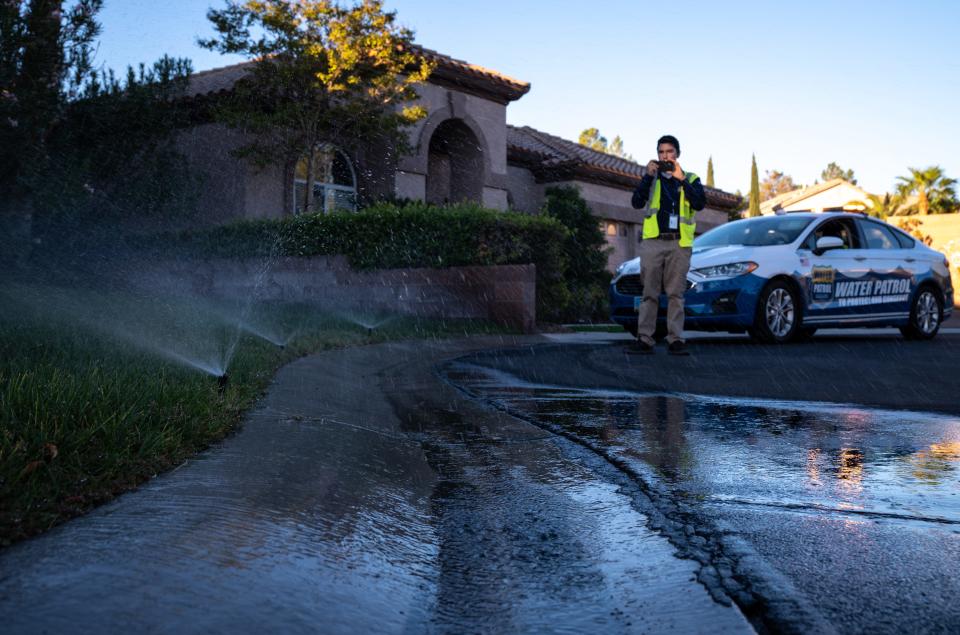
Southern Nevada’s most visible sign of the arid times is its corps of water cops, a dozen waste watchers who patrol neighborhoods at dawn in cars with flashing lights and paint jobs announcing their mandate “to conserve and protect.”
Cameron Donnarumma was among their ranks in September, scouring the Summerlin area of Las Vegas for any water streaming off lawns and down the street. Whenever he found some, he left a door hanger on the home advising them that they were out of compliance. If it was a second offense, he left a ticket for $80. They also face fines if they water on days not assigned to them by the water authority.
Ticketed properties can expect a repeat visit two weeks later to ensure compliance. Failure to fix the problem leads to a doubling of the fine on that water customer’s bill, eventually reaching as high as $1,280.
It never gets to that point, Donnarumma said. Many residents set their sprinklers for early morning and aren’t even aware they’re overwatering or spraying beyond their property until they get the notice.
“Most people don’t want to waste water,” he said.
That doesn’t mean he’s not busy. In summer, he issues corrective orders to 15 or 20 homeowners every morning. The struggle for water efficiency remains a daily grind.
Brandon Loomis covers environmental and climate issues for The Arizona Republic and azcentral.com. Reach him at brandon.loomis@arizonarepublic.com or follow on Twitter @brandonloomis.
Environmental coverage on azcentral.com and in The Arizona Republic is supported by a grant from the Nina Mason Pulliam Charitable Trust. Follow The Republic environmental reporting team at environment.azcentral.com and @azcenvironment on Facebook, Twitter and Instagram.
Support The Republic's coverage of the environment. Subscribe to azcentral.com today.
This article originally appeared on Arizona Republic: Lake Mead drought: Colorado River cities prep for water shortages

